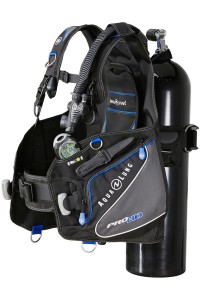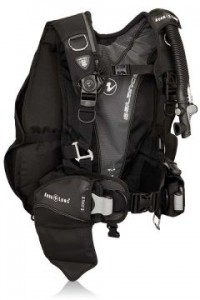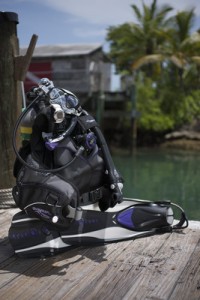In the early days of diving, there were no Buoyancy Compensator Devices (BCD’s). The diver just used a back plate and harness system to keep they tank secured to their back. For this reason, all scuba divers in the years prior to the invention of the BCD had to be good watermen, having to control their buoyancy solely on their breath control underwater, and swimming ability at the surface. The first recreational BCD was produced in 1970 and has continued to develop since then into an integral piece of diving equipment. They come in two main types and offer many different features.
How Your BC Works
Before we list the main types of BCD’s available on the market today, let’s first explore how your BC works in the first place. There are three main purposes for using a BC. The first is to be able to float (maintain positive buoyancy) at the surface before and after your dive. The second is to allow you to fine tune your buoyancy underwater during your dive. The third, and most overlooked purpose to using a BC is to secure your tank to your body.
3 Main Functions of Your BCD:
Float at the surface
Create neutral buoyancy underwater
To hold your tank
Features of Every BCD
Your tank is attached to the BCD by strong nylon straps and a backpack-style tank mount. Your regulator attached to your tank is then attached to your power inflator via a low-pressure inflator hose. This is how you inflate your BCD “bladder” with air. The inside of your BCD contains the air bladder, which is what holds the air in the BC. Your BC will come with a built in pressure release valve, protecting the air bladder from over inflating. It automatically dumps air once the bladder fills to it’s maximum capacity. Most BC’s will have multiple dump valves as well, allowing you, the diver, to let air out of your BC quickly by pulling on a cord to open the valve. Lastly, most modern BC’s come with integrated weight systems. These are pockets on either side of the BC made to hold the diver’s weights so they do not have to wear a weight belt. These pockets are made with quick release features to quickly dump the air in an emergency.
Types of BCD's
Listed above are all of the basic features of modern Buoyancy Compensators. These features will be found on almost all BCD’s you see in your local dive store. There are however, two styles of BC’s you will have to choose from: Jacket Style BC’s and Back-Inflate BC’s.
Jacket Style BC
- Good for divers who want to feel more secure in the water.
- Jacket BC’s generally have larger air bladders, therefore, holding the diver up higher out of the water at the surface.
- Air bladder wraps around the core of the diver’s body, floating the diver in a more upright position at the surface of the water.
- Not as streamlined in the water, but comfortable.
Back Inflation Style BC
- Air bladder is only located at the rear of the BC on the back of the diver, providing more ease of movement and less clutter on their front side.
- Back Inflate BC’s are more streamline than Jacket style BC’s.
- Back Inflate will not hold the diver very high out of the water at the surface.
- Most commonly used by more experienced divers.
The BCD style you end up using in the end is really more a mater of personal preference based on how you want to feel in the water. Trying out the different styles is really the only way to determine which BC works and feels best for you. Visit us at Underseas Scuba Center to find your BCD today.






